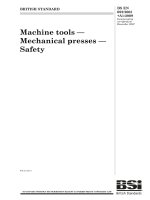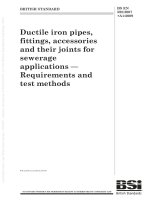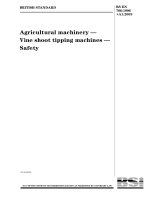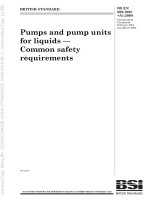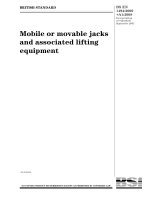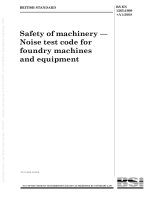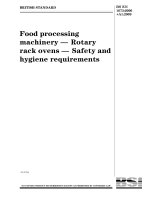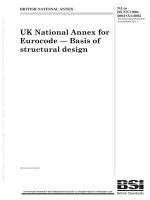Bsi bs en 00405 2001 + a1 2009
Bạn đang xem bản rút gọn của tài liệu. Xem và tải ngay bản đầy đủ của tài liệu tại đây (846.89 KB, 48 trang )
BRITISH STANDARD
Respiratory protective
devices — Valved
filtering half masks to
protect against gases or
gases and particles —
Requirements, testing,
marking
ICS 13.340.30
NO COPYING WITHOUT BSI PERMISSION EXCEPT AS PERMITTED BY COPYRIGHT LAW
BS EN
405:2001
+A1:2009
BS EN 405:2001+A1:2009
National foreword
This British Standard is the UK implementation of EN 405:2001+A1:2009. It
supersedes BS EN 405:2002 which is withdrawn.
The start and finish of text introduced or altered by amendment is indicated
in the text by tags. Tags indicating changes to CEN text carry the number of
the CEN amendment. For example, text altered by CEN amendment A1 is
indicated by !".
The UK participation in its preparation was entrusted to Technical
Committee PH/4, Respiratory protection.
A list of organizations represented on this subcommittee can be obtained on
request to its secretary.
This publication does not purport to include all the necessary provisions of a
contract. Users are responsible for its correct application.
Compliance with a British Standard cannot confer immunity from
legal obligations.
This British Standard was
published under the authority
of the Standards Policy and
Strategy Committee on
25 February 2002
Amendments/corrigenda issued since publication
© BSI 2009
Date
Comments
31 July 2009
Implementation of CEN amendment A1:2009, and
alignment of BSI and CEN publication dates
ISBN 978 0 580 62118 5
EUROPEAN STANDARD
EN 405:2001+A1
NORME EUROPÉENNE
EUROPÄISCHE NORM
May 2009
ICS 13.340.30
Supersedes EN 405:2001
English Version
Respiratory protective devices - Valved filtering half masks to
protect against gases or gases and particles - Requirements,
testing, marking
Appareils de protection respiratoire - Demi-masques
filtrants à soupapes contre les gaz ou contre les gaz et les
particules - Exigences, essais, marquage
Atemschutzgeräte - Filtrierende Halbmasken mit Ventilen
zum Schutz gegen Gase oder Gase und Partikeln Anforderungen, Prüfung, Kennzeichnung
This European Standard was approved by CEN on 8 November 2001 and includes Amendment 1 approved by CEN on 26 March 2009.
CEN members are bound to comply with the CEN/CENELEC Internal Regulations which stipulate the conditions for giving this European
Standard the status of a national standard without any alteration. Up-to-date lists and bibliographical references concerning such national
standards may be obtained on application to the CEN Management Centre or to any CEN member.
This European Standard exists in three official versions (English, French, German). A version in any other language made by translation
under the respons bility of a CEN member into its own language and notified to the CEN Management Centre has the same status as the
official versions.
CEN members are the national standards bodies of Austria, Belgium, Bulgaria, Cyprus, Czech Republic, Denmark, Estonia, Finland,
France, Germany, Greece, Hungary, Iceland, Ireland, Italy, Latvia, Lithuania, Luxembourg, Malta, Netherlands, Norway, Poland, Portugal,
Romania, Slovakia, Slovenia, Spain, Sweden, Switzerland and United Kingdom.
EUROPEAN COMMITTEE FOR STANDARDIZATION
COMITÉ EUROPÉEN DE NORMALISATION
EUROPÄISCHES KOMITEE FÜR NORMUNG
Management Centre: Avenue Marnix 17, B-1000 Brussels
© 2009 CEN
All rights of exploitation in any form and by any means reserved
worldwide for CEN national Members.
Ref. No. EN 405:2001+A1:2009: E
BS EN 405:2001+A1:2009
EN 405:2001+A1:2009 (E)
Contents
page
Foreword ...................................................................................................................................................................... 4
Introduction ................................................................................................................................................................. 5
1
Scope .............................................................................................................................................................. 6
2
Normative references .................................................................................................................................... 6
3
Terms and definitions ................................................................................................................................... 6
4
Description ..................................................................................................................................................... 6
5
5.1
5.2
5.2.1
5.2.2
5.2.3
5.3
5.4
Classification.................................................................................................................................................. 7
General ............................................................................................................................................................ 7
Types of gas filtering half masks ................................................................................................................. 7
Valved gas filtering half masks .................................................................................................................... 7
Valved multi-type gas filtering half masks .................................................................................................. 7
Valved combined filtering half masks ......................................................................................................... 7
Designs of combined valved filtering half masks ...................................................................................... 7
Classes of valved gas filtering half masks ................................................................................................. 8
6
Designation .................................................................................................................................................... 8
7
7.1
7.2
7.3
7.4
7.5
7.6
7.7
7.7.1
7.7.2
7.8
7.9
7.10
7.10.1
7.10.2
7.10.3
7.11
7.11.1
7.11.2
7.11.3
7.11.4
7.12
7.13
7.14
7.15
7.16
7.17
Requirements ................................................................................................................................................. 8
General ............................................................................................................................................................ 8
Nominal values and tolerances .................................................................................................................... 8
Visual inspection ........................................................................................................................................... 9
Packaging ....................................................................................................................................................... 9
Practical performance ................................................................................................................................... 9
Leakage ........................................................................................................................................................... 9
Filter penetration/capacity ............................................................................................................................ 9
Particle filter penetration .............................................................................................................................. 9
Gas filtering capacity .................................................................................................................................. 10
Finish of parts .............................................................................................................................................. 11
Inhalation and exhalation valves................................................................................................................ 11
Breathing resistance ................................................................................................................................... 12
General .......................................................................................................................................................... 12
Inhalation resistance ................................................................................................................................... 12
Exhalation resistance .................................................................................................................................. 13
Clogging ....................................................................................................................................................... 13
General .......................................................................................................................................................... 13
Devices with separable particle filters ...................................................................................................... 13
Devices with integral or separable particle filters .................................................................................... 13
Exhalation resistance .................................................................................................................................. 14
Compatibility with skin ................................................................................................................................ 14
Flammability ................................................................................................................................................. 14
Carbon dioxide content of the inhalation air ............................................................................................ 14
Head harness ............................................................................................................................................... 14
Field of vision ............................................................................................................................................... 15
Demountable parts ...................................................................................................................................... 15
8
8.1
8.2
8.3
8.3.1
8.3.2
2
Testing .......................................................................................................................................................... 15
General .......................................................................................................................................................... 15
Visual inspection ......................................................................................................................................... 15
Conditioning ................................................................................................................................................. 15
General .......................................................................................................................................................... 15
Donning and doffing .................................................................................................................................... 15
BS EN 405:2001+A1:2009
EN 405:2001+A1:2009 (E)
8.3.3
8.3.4
8.4
8.4.1
8.4.2
8.4.3
8.5
8.5.1
8.5.2
8.5.3
8.5.4
8.5.5
8.5.6
8.5.7
8.5.8
8.5.9
8.6
8.7
8.8
8.9
8.10
Temperature ................................................................................................................................................. 15
Mechanical strength .................................................................................................................................... 16
Practical performance ................................................................................................................................. 16
General.......................................................................................................................................................... 16
Walking test .................................................................................................................................................. 16
Work simulation test ................................................................................................................................... 16
Inward Leakage ............................................................................................................................................ 17
General.......................................................................................................................................................... 17
Principle ........................................................................................................................................................ 17
Apparatus ..................................................................................................................................................... 17
Conditioning and number of test samples................................................................................................ 18
Test subjects ................................................................................................................................................ 18
Preparation of samples ............................................................................................................................... 18
Test procedure ............................................................................................................................................. 19
Test using sulfur hexafluoride as test agent ............................................................................................ 20
Test using sodium chloride as test agent ................................................................................................. 21
Gas filtering capacity .................................................................................................................................. 23
Flammability ................................................................................................................................................. 23
Carbon dioxide content of the inhalation air ............................................................................................ 23
Breathing resistance ................................................................................................................................... 24
Strength of attachment exhalation valve housing ................................................................................... 25
9
9.1
9.2
9.2.1
9.2.2
9.3
Marking ......................................................................................................................................................... 25
Packaging ..................................................................................................................................................... 25
Valved gas filtering half mask with separable particle filters ................................................................. 25
Valved gas filtering half mask .................................................................................................................... 25
Separable particle filters ............................................................................................................................. 26
Valved gas filtering half masks with integral particle filters ................................................................... 26
10
Information supplied by the manufacturer ............................................................................................... 27
Annex A (informative) Marking ................................................................................................................................ 43
Annex ZA (informative) Clauses of this European Standard addressing essential requirements or other
provisions of EU Directives ........................................................................................................................ 44
Bibliography .............................................................................................................................................................. 45
3
BS EN 405:2001+A1:2009
EN 405:2001+A1:2009 (E)
Foreword
This document (EN 405:2001+A1:2009) has been prepared by Technical Committee CEN/TC 79 “Respiratory
protective devices“, the secretariat of which is held by DIN.
This European Standard shall be given the status of a national standard, either by publication of an identical text or
by endorsement, at the latest by November 2009, and conflicting national standards shall be withdrawn at the latest
by November 2009.
This European Standard supersedes !EN 405:2001".
This document includes Amendment 1, approved by CEN on 2009-03-26.
The start and finish of text introduced or altered by amendment is indicated in the text by tags !".
This draft European Standard has been prepared under a mandate given to CEN by the European Commission
and the European Free Trade Association, and supports essential requirements of EU Directive 89/686/EEC.
For relationship with EU Directive, see informative Annex ZA, which is an integral part of this standard.
The annexes A and ZA are informative.
According to the CEN/CENELEC Internal Regulations, the national standards organizations of the following
countries are bound to implement this European Standard: Austria, Belgium, Bulgaria, Cyprus, Czech Republic,
Denmark, Estonia, Finland, France, Germany, Greece, Hungary, Iceland, Ireland, Italy, Latvia, Lithuania,
Luxembourg, Malta, Netherlands, Norway, Poland, Portugal, Romania, Slovakia, Slovenia, Spain, Sweden,
Switzerland and the United Kingdom.
4
BS EN 405:2001+A1:2009
EN 405:2001+A1:2009 (E)
Introduction
A given respiratory protective device can only be approved when the individual components satisfy the
requirements of the test specification which may be a complete standard or part of a standard, and practical
performance tests have been carried out successfully on complete apparatus where specified in the appropriate
standard. If for any reason a complete apparatus is not tested then simulation of the apparatus is permitted
provided the respiratory characteristics and weight distribution are similar to those of the complete apparatus.
5
BS EN 405:2001+A1:2009
EN 405:2001+A1:2009 (E)
1
Scope
This European Standard specifies the performance requirements, test methods and marking requirements for
valved filtering half masks incorporating either gas or combined filters as respiratory protective devices except for
escape purposes. It does not cover gas filtering half masks which do not have valves or are fitted only with
exhalation valves. It does not cover devices designed for use in circumstances where there is or might be an
oxygen deficiency (oxygen less than a volume fraction of 17 %).
Laboratory and practical performance tests are included for the assessment of compliance with the requirements.
2
Normative references
!The following referenced documents are indispensable for the application of this document. For dated
references, only the edition cited applies. For undated references, the latest edition of the referenced document
(including any amendments) applies."
EN 132, Respiratory protective devices - Definition of terms and pictograms
EN 134, Respiratory protective devices - Nomenclature of components
!deleted text"
EN 143, Respiratory protective devices - Particle filters - Requirements, testing, marking
!deleted text"
!EN 13274-7, Respiratory protective devices – Methods of test – Part 7: Determination of particle filter
penetration
EN 14387, Respiratory protective devices – Gas filter(s) and combined filter(s) - Requirements, testing, marking"
3
Terms and definitions
For the purposes of this European Standard the terms and definitions in EN 132 and the nomenclature given in
EN 134 apply !together with the following:
3.1
re-usable particle filtering component for valved combined filtering half mask
particle filtering component which is intended to be used for more than a single shift"
4
Description
A valved filtering half mask covers the nose and mouth and the chin and has both inhalation and exhalation valves
and
a)
consists entirely or substantially of filter material or,
b)
comprises a facepiece in which the gas filter(s) form(s) an inseparable part of the device and where particle
filters can be replaceable.
It provides adequate sealing for the intended use on the face of the wearer against the ambient atmosphere, when
the skin is dry or moist and when the head is moved.
6
BS EN 405:2001+A1:2009
EN 405:2001+A1:2009 (E)
Inhaled air enters through the filter material and through an inhalation valve(s). Exhaled air passes through an
exhalation valve(s) to the ambient atmosphere.
Since the devices are discarded on depletion of the gas filter, it is not expected that replaceable components will be
provided, e.g. valves or head harness.
In addition to providing protection against gases and vapours these devices can be designed to also protect
against solid and liquid aerosols.
Gas filters remove specified gases and vapours. Combined filters remove dispersed solid and liquid particles and
specified gases and vapours.
5
Classification
5.1 General
Gas and combined valved filtering half masks are classified into types and classes according to their application
and protection capacity.
5.2 Types of gas filtering half masks
5.2.1
Valved gas filtering half masks
Type FFA — for use against certain organic gases and vapours with a boiling point higher than 65 °C as specified
by the manufacturer.
Type FFB — for use against certain inorganic gases and vapours as specified by the manufacturer (excluding
carbon monoxide).
Type FFE — for use against sulfur dioxide and other acid gases and vapours as specified by the manufacturer.
Type FFK — for use against ammonia and organic ammonia derivatives as specified by the manufacturer.
Type FFAX — for use against certain low boiling organic compounds as specified by the manufacturer.
Type FFSX — for use against specific named gases and vapours.
5.2.2
Valved multi-type gas filtering half masks
Gas valved filtering half masks which are a combination of two or more of the above types and which meet the
requirements of each type separately.
5.2.3
Valved combined filtering half masks
Gas or multi-type valved gas filtering half masks incorporating a particle filter. !In addition, the particle filtering
component of the half masks are classified as single shift use only or re-usable (more than one shift)."
5.3 Designs of combined valved filtering half masks
There are two designs of valved combined filtering half masks described in this European Standard: one with
integral particle filter(s), the second one with replaceable particle filter(s). Examples of classifications are:
!FFA1P1 NR D; FFA1P2 R D."
„D“ stands for optional clogging with dolomite.
7
BS EN 405:2001+A1:2009
EN 405:2001+A1:2009 (E)
5.4 Classes of valved gas filtering half masks
Valved filtering half masks may incorporate gas filters of types listed in 5.2.1 or 5.2.2, belonging to one of the two
following classes relating to their capacity:
Class 1 — low capacity FFGas1 filtering half mask e.g. FFA1;
Class 2 — medium capacity FFGas2 filtering half mask e.g. FFB2.
The protection provided by Class 2 devices includes that provided by the corresponding Class 1 device of the same
type.
FFAX and FFSX devices are not classified in accordance with this clause.
6
Designation
Valved filtering half masks meeting the requirements of this European Standard shall be designated in the following
manner:
!Valved filtering half mask EN 405, year of publication, type, classification, option (where "D" is an option for a
non re-useable particle filtering component and mandatory for re-useable particle filtering component).
EXAMPLE
7
Valved filtering half mask EN 405:2001 FFA2P3 NR D"
Requirements
7.1 General
In all tests, all test samples shall meet the requirements.
7.1.1 Materials used shall be suitable to withstand handling and wear over the period for which the valved filtering
half mask is designed to be used.
Testing shall be done in accordance with 8.4.
After undergoing the treatment described in 8.3.2 and 8.3.3 none of the devices shall collapse or shall have
suffered mechanical failure of the facepiece body or straps.
7.1.2 Any material of the filter media or any gaseous products that may be released by the airflow through the
filter shall not be known to constitute a hazard or nuisance for the wearer.
Testing shall be done in accordance with 8.2.
7.1.3 !If the valved filtering half mask is designed to be re-usable, the materials used shall withstand the
cleaning and disinfecting agents and procedures to be specified by the manufacturer.
With reference to 7.7.1, for valved filtering half mask with non separable particle filters, after cleaning and
disinfecting the re-usable valved filtering half mask shall satisfy the penetration requirement of the relevant class.
Testing shall be done in accordance with 7.7.1 using EN 13274-7.
NOTE
Separable filters are not subjected to cleaning and disinfecting."
7.2 Nominal values and tolerances
Unless otherwise specified, the values stated in this European Standard are expressed as nominal values. Except
for temperature limits, values which are not stated as maxima or minima shall be subject to a limit deviation of
8
BS EN 405:2001+A1:2009
EN 405:2001+A1:2009 (E)
± 5 %. Unless otherwise specified, the ambient temperature for testing shall be from 16 °C to 32 °C, and the
temperature limits shall be subject to a limit deviation of ± 1 °C.
7.3 Visual inspection
The visual inspection shall also include the marking and information supplied by the manufacturer.
7.4 Packaging
Valved filtering half masks shall be offered for sale packaged in such a way that they are protected against
mechanical damage and contamination before use.
They shall be factory sealed to protect the filter media against environmental influences in such a way, that the
breaking of the factory sealing can be identified.
Testing shall be done in accordance with 8.2.
7.5 Practical performance
The device shall undergo practical performance tests under realistic conditions. These general tests serve the
purpose of checking the equipment for imperfections that cannot be determined by the tests described elsewhere in
this European Standard.
Where practical performance tests show the apparatus has imperfections related to wearer's acceptance, the test
house shall provide full details of those parts of the practical performance tests which revealed these imperfections.
Testing shall be done in accordance with 8.4.
7.6 Leakage
When the valved filtering half mask is tested in accordance with 8.5, the values of inward leakage (total inward
leakage excluding filter penetration) shall comply with the following.
At least 46 out of the 50 individual results for the inward leakage over each of the exercise periods as defined in 8.5
(i.e. 10 subjects × 5 exercise periods) shall be not greater than 5 %.
In addition, at least 8 out of the 10 individual wearer arithmetic means of measured values (10 subjects) for the
inward leakage, averaged over all exercise periods shall be not greater than 2 %.
Testing shall be done in accordance with 8.5.
7.7 Filter penetration/capacity
7.7.1
Particle filter penetration
For all devices the penetration of the particle filter of the valved filtering half mask, whether with integral or
separable filters, shall meet the requirements given in Table 1.
9
BS EN 405:2001+A1:2009
EN 405:2001+A1:2009 (E)
Table 1 — Particle filter penetration
Classification
Maximum initial penetration of test aerosols at 95 l/min
FFGasP1
Sodium chloride
%
20
Paraffin oil
%
20
FFGasP2
6
6
FFGasP3
1
1
!A total of 6 samples of valved combined filtering half masks shall be tested for each aerosol.
The Penetration test according to EN 13274-7 shall be performed on:
-
3 samples as received.
The Exposure test with a specified mass of test aerosol of 120 mg, and for valved filtering half mask claimed to be
re-usable additionally the Storage test, according to EN 13274-7, shall be performed:
- for non-re-usable devices on:
- 3 samples after the test for mechanical strength in accordance with 8.3.4 followed by temperature
conditioning in accordance with 8.3.3.
- for re-usable devices on:
- 3 samples after the test for mechanical strength in accordance with 8.3.4 followed by temperature
conditioning in accordance with 8.3.3 and followed by one cleaning and disinfecting cycle according to
the manufacturer's instruction."
Separable particle filters, other than prefilters, designed to be used additionally with devices other than devices
according to this standard shall meet the requirements of EN 143.
7.7.2
Gas filtering capacity
7.7.2.1 When tested in accordance with 8.6 the devices shall meet the requirements given in Table 2 for minimum
breakthrough times for FFGas1 and/or FFGas2 devices and/or the requirements of !EN 14387".
10
BS EN 405:2001+A1:2009
EN 405:2001+A1:2009 (E)
Table 2 — Gas filtering capacity
Classification
Test agent
Test gas
concentration in air
Breakthrough
concentration
% by
volume
0,1
mg/l
3,5
ml/m
10
Minimum
breakthrough
time
3
min
70
FFA1
Cyclohexane (C6H12)
FFB1
Chlorine (Cl2)
0,1
3,0
0,5
20
Hydrogen sulfide (H2S)
0,1
1,4
10
40
a
25
Hydrogen cyanide (HCN)
0,1
1,1
10
FFE1
Sulfur dioxide (SO2)
0,1
2,7
5
20
FFK1
Ammonia (NH3)
0,1
0,7
25
50
FFA2
Cyclohexane (C6H12)
0,5
17,5
10
35
FFB2
Chlorine (Cl2)
0,5
15,0
0,5
20
Hydrogen sulfide (H2S)
0,5
7,1
10
40
a
25
Hydrogen cyanide (HCN)
0,5
5,6
10
FFE2
Sulfur dioxide (SO2)
0,5
13,3
5
20
FFK2
Ammonia (NH3)
0,5
3,5
25
40
NOTE
The minimum breakthrough time is intended only for laboratory tests under standardized
conditions. It does not give an indication of the possible service time in practical use. Possible service times
can differ from the breakthrough times determined according to this European Standard in both directions
positive or negative depending on the conditions of use.
a
C2N2 may sometimes be present in the effluent air. The total concentration of (C2N2 + HCN)
3
shall not exceed 10 ml/m .
7.7.2.2 Where a device is a combination of types, it shall meet the requirements of each type separately.
7.7.2.3 Test requirements shall apply to the capacity of the complete device.
7.8 Finish of parts
Parts of the device likely to come into contact with the wearer shall have no sharp edges or burrs.
Testing shall be done in accordance with 8.2.
7.9 Inhalation and exhalation valves
7.9.1 Inhalation valve(s) and exhalation valve(s) shall function correctly in all orientations.
Testing shall be done in accordance with 8.9.
7.9.2 Exhalation valve(s) shall be protected against or be resistant to dirt and mechanical damage. They may be
shrouded or may include any other device that may be necessary to comply with 7.6.
Testing shall be done in accordance with 8.2.
7.9.3 Exhalation valve(s) shall continue to operate correctly after a continuous exhalation flow of 300 l/min over a
period of 30 s.
Testing shall be done in accordance with 8.9.
11
BS EN 405:2001+A1:2009
EN 405:2001+A1:2009 (E)
7.9.4 The exhalation valve housing shall show no signs of damage or of being loosened.
Testing shall be done in accordance with 8.10.
7.10 Breathing resistance
7.10.1 General
The breathing resistances of the various classes of valved gas and combined filtering half masks shall meet the
requirements of 7.10.2 and 7.10.3.
7.10.2 Inhalation resistance
7.10.2.1
Valved gas filtering half masks
When tested in accordance with 8.9 the inhalation resistance shall meet the requirements given in Table 3.
Table 3 — Inhalation resistance: valved gas filtering half masks
Classification
7.10.2.2
Maximum inhalation resistance
mbar
FFGas1
30 l/min
1,0
95 l/min
4,0
FFGas2
1,4
5,6
FFAX
1,4
5,6
FFSX
1,4
5,6
Valved combined filtering half masks
When tested in accordance with 8.9, the inhalation resistance of all devices, whether with separable or integral
particle filters, shall meet the requirements given in Table 4.
12
BS EN 405:2001+A1:2009
EN 405:2001+A1:2009 (E)
Table 4 — Inhalation resistance: valved combined filtering half masks
Maximum inhalation resistance
mbar
Classification
FFGas1P1
30 l/min
1,6
95 l/min
6,1
FFGas1P2
1,7
6,4
FFGas1P3
2,0
7,0
FFGas2P1
2,0
7,7
FFGas2P2
2,1
8,0
FFGas2P3
2,4
8,6
FFAXP1
2,0
7,7
FFAXP2
2,1
8,0
FFAXP3
2,4
8,6
FFSXP1
2,0
7,7
FFSXP2
2,1
8,0
FFSXP3
2,4
8,6
7.10.3 Exhalation resistance
When tested in accordance with 8.9, the exhalation resistance of the valved gas or combined filtering half mask
shall not exceed 3 mbar.
7.11 Clogging
7.11.1 General
This test is applicable to all valved combined filtering half masks. For !single shift use" devices only, the
clogging test is optional.
7.11.2 Devices with separable particle filters
Where the particle filters of devices with separable particle filters are claimed only to meet this standard, the filters
shall meet the requirements of 7.11.3.
Where the particle filters of devices with separable particle filters are additionally claimed to meet EN 143, the filters
shall additionally meet the respective requirements of EN 143.
Testing shall be done in accordance with 8.9 and EN 143.
7.11.3 Devices with integral or separable particle filters
Where devices with integral or separable particle filters are claimed to meet clogging performance requirements
they shall be subjected to the dolomite dust clogging procedure given in EN 143. The breathing resistance shall
then be measured in accordance with 8.9 and the device shall meet the requirements given in Table 5 and 7.11.4.
The filter penetration shall not exceed the values given in Table 1.
!Valved combined filtering half masks claimed to meet the clogging requirement shall also meet the
requirements given in Table 1, for the Penetration test according to EN 13274-7, after the clogging treatment."
13
BS EN 405:2001+A1:2009
EN 405:2001+A1:2009 (E)
Table 5 — Inhalation resistance
Classification
Maximum inhalation resistance at 95 l/min
mbar
FFGas1P1
8,0
FFGas1P2
9,0
FFGas1P3
9,8
FFGas2P1
9,6
FFGas2P2
10,6
FFGas2P3
11,4
FFAXP1
9,6
FFAXP2
10,6
FFAXP3
11,4
FFSXP1
9,6
FFSXP2
10,6
FFSXP3
11,4
Testing shall be done in accordance with 8.9 !,EN 143 and EN 13274-7".
7.11.4 Exhalation resistance
When tested in accordance with 8.9 the exhalation resistance of a valved combined filtering half mask with either
separable or integral particle filters shall not exceed 3,0 mbar.
7.12 Compatibility with skin
Materials that may come into contact with the wearer's skin shall not be known to be likely to cause irritation or any
other adverse effect to health.
Testing shall be done in accordance with 8.2, 8.4 and 8.5.
7.13 Flammability
The materials used shall not present a danger for the wearer and shall not be of highly flammable nature.
When tested in accordance with 8.7 a valved filtering half mask shall either not burn or not continue to burn for
more than 5 s after removal from the flame.
It is not required that the valved filtering half mask still has to be useable after the test.
Testing shall be done in accordance with 8.7.
7.14 Carbon dioxide content of the inhalation air
When tested in accordance with 8.8 the carbon dioxide content of the inhalation air (dead space) shall not exceed
an average of a volume fraction of 1,0 %.
7.15 Head harness
7.15.1 The head harness shall be designed so that the valved filtering half mask can be donned and removed
easily.
14
BS EN 405:2001+A1:2009
EN 405:2001+A1:2009 (E)
Testing shall be done in accordance with 8.4.
7.15.2 The head harness shall be adjustable or self-adjusting and shall be sufficiently robust to hold the valved
filtering half mask firmly in position and be capable of maintaining inward leakage requirements for the device.
Testing shall be done in accordance with 8.4 and 8.5.
7.16 Field of vision
The field of vision is acceptable if determined so in practical performance tests.
Testing shall be done in accordance with 8.4.
7.17 Demountable parts
All demountable parts (if fitted) shall be readily connected and secured, where possible by hand.
Testing shall be done in accordance with 8.2 and 8.4.
8
Testing
8.1 General
All samples shall fulfill all requirements.
Before performing tests involving human subjects account should be taken of any national regulations concerning
the medical history, examination or supervision of the test subjects.
NOTE
For summary of testing see Table 6.
8.2 Visual inspection
The visual inspection shall be carried out where appropriate by the test station prior to laboratory or practical
performance tests.
8.3 Conditioning
8.3.1
General
Where conditioning is required before subsequent testing the procedures used shall be one or more of those
described in 8.3.2, 8.3.3, 8.3.4 as specified in Table 6.
Devices shall be removed from their packaging but still be sealed.
8.3.2
Donning and doffing
The wearers shall fit the valved filtering half mask in accordance with the manufacturer's information and then
remove it.
8.3.3
Temperature
The valved filtering half masks as received shall be exposed to the following thermal cycle:
a)
for 24 h to a dry atmosphere at (70 ± 3) °C;
b)
for 24 h to a temperature of (–30 ± 3) °C
15
BS EN 405:2001+A1:2009
EN 405:2001+A1:2009 (E)
and allowed to return to room temperature for at least 4 h between exposures and prior to subsequent testing.
The conditioning shall be carried out in a manner which ensures that no thermal shock occurs.
8.3.4
8.3.4.1
Mechanical strength
Apparatus
The apparatus as shown schematically in Figure 1, consists of a steel case (K) which is fixed on a vertically moving
piston (S), capable of being lifted up to 20 mm by a rotating cam (N) and dropping down onto a steel plate (P)
under its own mass as the cam rotates. The mass of the steel case shall be more than 10 kg. The mass of the steel
plate onto which the steel case falls should be at least 10 times the mass of the steel case. This may be achieved
by bolting the steel plate to a hard floor without dampening elements.
8.3.4.2
Procedure
The valved filtering half mask shall be tested in the sealed condition as described in 7.4.
The devices shall be placed vertically in the case (K) so that the sealed packages do not touch each other during
the test, allowing 6 mm horizontal movement and free vertical movement. The test apparatus shall be operated at
-1
the rate of approximately 100 min for approximately 20 min and a total of 2 000 rotations. After the test, any loose
material that may have been released from the device shall be removed prior to the performance testing.
8.4 Practical performance
8.4.1
General
A total of 2 valved filtering half masks shall be tested: both as received.
Prior to the test the valved filtering half masks shall be examined to ensure that they are in good working order and
can be used without hazard.
All tests shall be carried out by two test subjects at ambient temperature and the test temperature and humidity
shall be recorded.
For the test, persons shall be selected who are familiar with using such or similar equipment.
During the tests, the valved filtering half mask shall be subjectively assessed by the wearer and, after the test,
comments on the following shall be recorded:
a)
head harness comfort;
b)
security of fastenings;
c)
field of vision;
d)
any other comments reported by the wearer on request.
8.4.2
Walking test
The subjects wearing normal working clothes and wearing the valved filtering half mask shall walk at a regular rate
of 6 km/h on a level course. The test shall be continuous, without removal of the valved filtering half mask, for a
period of 10 min.
8.4.3
Work simulation test
During this test the following activities shall be carried out in simulation of the practical use of the valved filtering
half mask. The test shall be completed within a total working time of 20 min.
16
BS EN 405:2001+A1:2009
EN 405:2001+A1:2009 (E)
The sequence of activities is at the discretion of the testofficer. The individual activities shall be arranged so that
sufficient time is left for the comments prescribed.
a)
Walking on the level with headroom of (1,3 ± 0,2) m for 5 min;
b)
Crawling on the level with headroom of (0,70 ± 0,05) m for 5 min;
c)
Filling a small basket (see Figure 2, approximate volume = 8 l) with chippings or other suitable material from a
hopper which stands 1,5 m high and has an opening at the bottom to allow the contents to be shovelled out
and a further opening at the top where the basket full of chippings shall be returned. The subject shall stoop or
kneel (as desired) and fill the basket with chippings. The test subject shall then lift the basket and empty the
contents back into the hopper. This shall be done 20 times in 10 min.
8.5 Inward Leakage
8.5.1
General
A total of 10 samples shall be tested: five in the state as received and five after temperature conditioning in
accordance with 8.3.3.
The samples, depending upon design, can require modification in order to ensure that the measurements taken,
are those corresponding to faceseal leakage. This is done by modifying the test sample (as per examples provided
in 8.5.6) to ensure that any contribution to inward leakage, attributable to filter penetration, will be negligible.
The test arrangement and the test procedure are common to both test agents.
8.5.2
Principle
A test subject wearing a device conditioned as specified, walks at a specified speed on a horizontal treadmill
surrounded by an atmosphere containing a known concentration of a test agent. The percentage inward leakage of
the test agent into the breathing zone is measured.
Two methods are specified, namely, one using sodium chloride and the other sulphur hexafluoride. The general
principle of the test is the same.
Dilution of the test atmosphere by clean air emanating from the device under test does not affect the accuracy of
the measurement of leakage because of the large volume and continuous replacement of the test atmosphere.
8.5.3
8.5.3.1
Apparatus
Enclosure
An enclosure shall be positioned over a treadmill and shall be capable of being charged with the test agent, which
preferably enters the top of the enclosure via a duct and flow distributor and shall be directed downwards over the
head of the test subject. The concentration of the test agent inside the effective working volume shall be checked to
ensure it is homogeneous. The enclosure shall be large enough to permit walking on the treadmill without
interference.
The air velocity through the enclosure measured close to the test subject's head, with the test subject standing
centrally on the treadmill shall be 0,1 m/s to 0,2 m/s.
The design of the enclosure shall be such that the device worn by the test subject can be supplied if necessary with
breathable air (free of the test agent).
It is important that the attachment of the hose supplying clean air does not affect the fit of the device on the test
subject nor should its fitting replace any seals incorporated in the device under test. If necessary the hose can be
supported.
17
BS EN 405:2001+A1:2009
EN 405:2001+A1:2009 (E)
8.5.3.2
Treadmill
A level treadmill capable of working at 6 km/h.
8.5.3.3
Sampling probe
The probe shall be fitted securely in an airtight manner to the device as near as possible to the centre line of the
device. A multiple hole sampling probe is strongly recommended. For the method using sodium chloride measures
shall be taken to prevent the influence of condensation in the sampling probe on the measurement by supplying dry
air. Figure 5 shows a design that has been found suitable. The probe is adjusted so that it just touches the wearer's
lips.
8.5.3.4
Detection systems
The detection system including sampling probes and connections shall have a response time of less than 20 s for a
response of 10 % to 90 % of the full scale deflection of the indicator used.
8.5.4
Conditioning and number of test samples
10 samples shall be tested: five in the state as received and five after temperature conditioning in accordance with
8.3.3.
8.5.5
Test subjects
Test subjects shall be selected from persons who are familiar with using such or similar equipment.
A panel of ten clean-shaven persons (without beards or sideburns) shall be selected covering the spectrum of facial
characteristics of typical users (excluding significant abnormalities). It is to be expected that exceptionally some
persons cannot be satisfactorily fitted with a device. Such exceptional subjects shall not be used in this test. In the
test report, the faces of the ten test subjects shall be described (for information only) by the four facial dimensions
(in millimetres) illustrated in Figure 6.
8.5.6
8.5.6.1
Preparation of samples
General
The procedures described in 8.5.6.2 and 8.5.6.3 provide ways in which devices can be prepared for face seal
leakage measurements. The procedure in 8.5.6.2 involves the use of integral or separable P3 filters and utilizes a
total inward leakage method; that in 8.5.6.3 involves the provision of a supply of clean air to the device and utilizes
a face seal leakage method.
8.5.6.2
Devices with integral or separable P3 filters
If the device is equipped with high efficiency particle filter(s) or available with optional high efficiency particle filters,
and the facepiece elements are common throughout the range, this option may be used to test (provided that the
mass and breathing resistance is consistent with the worst case arrangement) without further modification to
provide the face seal leakage results required.
Alternatively, it may be possible to bond/attach high efficiency particle filters to the filter area(s) - possibly by their
attachment to the plenum housing described in 8.5.6.3.1. This "surrogate" device shall then be used for testing.
When the device is not ordinarily available with high efficiency particle filters, the total resistance and mass of the
"surrogate" device shall be adjusted to match that of the original device.
18
